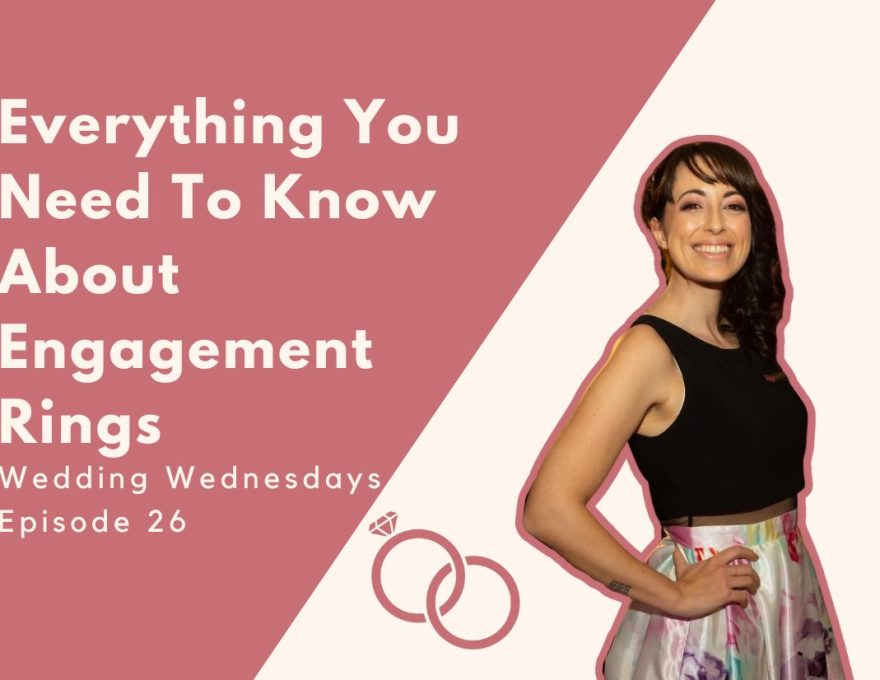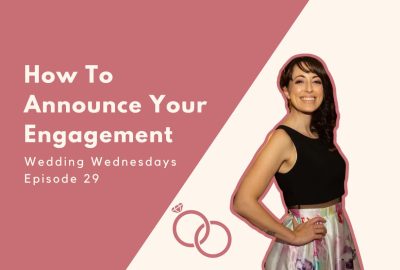Finding the perfect engagement ring comes easy to some, but for others they only know that they’ve found the right ring when it’s on the finger. For those who don’t know the difference between carat and karat, or silver and white gold, we’ve gathered everything you need to know about engagement rings.
This is part 1 of our 4 part series on popping the question!
Part 1: Everything you need to know about engagement rings
Part 2: How to plan your proposal
Part 3: What to say when you propose (besides the obvious)
Part 4: Engagement announcement ideas
Listen on Apple podcasts here!
Episode breakdown
Diamonds
If you are opting for the classic diamond, it’s important to brush up on your knowledge of ‘the four Cs’: Cut, Colour, Clarity and Carat.
Cut: This refers to the shape of the diamond when viewed from the top. Examples of cuts: round, oval, cushion, princess, emerald, pear, marquise, heart, asscher, trillion
Colour: The amount of yellowness found within a diamond is measured on a scale of ‘Colourless’ to ‘Fancy yellow’.
Clarity: Inclusions are small imperfections inside natural diamonds. The fewer the visual imperfections, the better the clarity rating.
Carat: A Carat doesn’t refer to a diamond’s size, but rather to its weight. 1 Carat is equal to 0.2 grams.
Rings
Believe it or not, there are three factors to consider when selecting the perfect ring to suit your diamond: Karat, Metal and Setting.
Karat: This is how we measure the fineness of gold. Karats are measured in units of 24, so 18k gold is considered to be 18/24 or 75%. 24 Karat gold is 100% gold.
Metal: You’ve got a variety of metals to choose from: Platinum, Silver, White Gold, Yellow Gold and Rose Gold, which are the most popular options. Other choices include Palladium, Steel, Titanium, Ceramic and Tungsten.
Setting: Your ring’s job is to hold the stone securely, and you’ll have four setting options to choose from: Prongs, Bezel, Channel and Pave.
Prongs: four hooks or claws that suspend the diamond in place slightly above the band.
Bezel: has a metal rim which surrounds the diamond and secures it in place.
Channel: the diamonds sit on a metal channel right beside each other and flow smoothly around the band.
Pave: a cluster of small diamonds encrusted along the surface of the band.
What to choose
Surprise or not? Talk about it!
If it’s a surprise:
- Consider their existing jewellery collection to get an idea of their preferred aesthetic
- If you have no idea at all, ask a trusted friend to do some sleuthing
Or shop together!
How to clean your diamond engagement ring
I’ve seen many debates about rings: should you clean it yourself or leave it to the pros? Can you take off your engagement ring or is it safer to keep it on at all times? With questions like these, I believe the answer is different for everyone. Personally, I keep my ring on unless I’m lifting gym weights. I know women who take their rings off when they sleep. It really is a personal choice!
So, if you are one of the girls who’d like to know how to clean your own diamond ring, I’ve got the inside scoop!
Mix warm (almost hot) water with dishwashing soap, shampoo or bodywash. Soak your ring for about 20 to 40 minutes and then gently brush it with a very soft toothbrush. Rinse under warm running water, and repeat if needed.
Note: Don’t use anything moisturising to wash your ring. This is why there’s build-up in the first place. When drying your ring, avoid paper towels. These actually leave scratches on the metal, so rather use soft cloth made of cotton, or just let it air dry.
A week or so before your wedding, take your ring to a jeweller to get it professionally cleaned for the Big Day.
When not to wear your engagement ring
During a workout – you can damage your ring over time, especially if you lift weights. Even body weight workouts can have this effect.
At the beach or doing any kind of swimming – you could lose it under water and the salt water and chlorine can dull its sparkle.
When you’re applying lotion – Body washes, lotions and moisturisers can affect the brilliance and shine of your ring over time.
While wearing gloves – When it’s cold, your ring size naturally decreases so it’s easier to slip off your finger. When you take off your gloves, they can easily pull your engagement ring off.
When it doesn’t fit properly – If your ring is too big or too small you can unintentionally damage it, or worse, lose it! Just take it to the jeweller who can fix and resize it.



